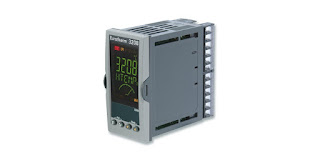 |
| One of many single loop process controller variants. Image courtesy Eurotherm |
There are many variants of process controllers, each providing some combination of input, output, interface, alarm and other functional options. They range from simple on/off devices to programmable microprocessor based units providing a wide range of functions in addition to control of a process parameter.
A single loop controller focuses its function on the regulation of one input value. The control algorithm and output action are directed solely at a single process value. An example would be a temperature controller. A single input from a thermocouple, RTD or other measurement instrument powers the control algorithm, which in turn adjusts the output action to affect any change needed to keep the process valve, or input, at a setpoint. The single input point may be used to drive more than one output, in this example a heating and a cooling output, but a single loop controller is generally limited to one process value input.
Process controllers can deliver an extensive range of auxiliary functions, in addition to straight line process control. The enhanced functionality can negate the need for additional hardware in the form of separate devices and instruments with their added burden of calibration, maintenance and repair. The list of available options is long, but here are some that may prove useful.
- Alarm outputs that can be programmed to respond to certain input conditions and annunciate a process condition out of the expected range.
- Retransmisson of the process signal as an analog output for use with other instruments.
- Flexible configuration via PC to speed setup or change of use.
- Recipe storage of process control setpoint changes for quick setup for differing batch operations.
- Customizable alarm messages to enhance operator understanding of their meaning.
- Communications for integration with larger control systems or data acquisition equipment.
- Remote setpoint input.
- Setpoint time or event based profile programming.
- Universal input section to accommodate wide range of input devices and enable deployment of a common controller model to many applications and locations throughout a facility.
There are more options and functions than can be effectively listed here. Share your process control challenges with a process measurement and control specialist. Effective solutions will arise from leveraging your own process knowledge and experience with their product application expertise.